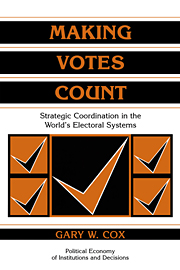Book contents
- Frontmatter
- Contents
- List of tables and figures
- Series Editors' Preface
- Preface
- PART I INTRODUCTION
- PART II STRATEGIC VOTING
- PART III STRATEGIC ENTRY
- PART IV ELECTORAL COORDINATION AT THE SYSTEM LEVEL
- PART V COORDINATION FAILURES AND DEMOCRATIC PERFORMANCE
- PART VI CONCLUSION
- APPENDICES
- A Formulaic structures in 77 democracies, circa 1992
- B Notation and proofs for Chapter 6
- C Data and sources for Chapter 11
- References
- Subject Index
- Author Index
B - Notation and proofs for Chapter 6
Published online by Cambridge University Press: 05 August 2012
- Frontmatter
- Contents
- List of tables and figures
- Series Editors' Preface
- Preface
- PART I INTRODUCTION
- PART II STRATEGIC VOTING
- PART III STRATEGIC ENTRY
- PART IV ELECTORAL COORDINATION AT THE SYSTEM LEVEL
- PART V COORDINATION FAILURES AND DEMOCRATIC PERFORMANCE
- PART VI CONCLUSION
- APPENDICES
- A Formulaic structures in 77 democracies, circa 1992
- B Notation and proofs for Chapter 6
- C Data and sources for Chapter 11
- References
- Subject Index
- Author Index
Summary
PART 1: THE VOTER'S DECISION PROBLEM
This appendix considers how a voter motivated solely by a desire to affect the outcome of the election decides which candidate to vote for, given that she votes. There are two parameters in the voter's decision (subscript I'S are suppressed and the distribution of utility types F is taken as given): First, the voter's preferences over the candidates, given by u ∈ U; second, the voter's expectations about how well each candidate will do at the polls.
I model voter expectations as follows. Each voter i views the candidates' vote totals (exclusive of her own vote) as random variables V1, …, VK governed by a joint distribution function, gn (v1, …,vk). I assume that the mean of gn does not depend on n (the number of voters), although n may affect higher-order moments. It may be, for example, that gn is the K-nomial distribution with parameters π = (π1, …,πk) and n –1. This is the case considered by Palfrey (1989), Cox (1994), and in Chapter 4.
I assume that the joint distribution gn is common knowledge. This entails common knowledge of the expected vote shares of the candidates, denoted π = (π1, …,πk) = E(V1/ – 1), …,VK(n – 1)/ gn), and of the tie-probabilities relevant in the voter's expected utility calculation.
Information
- Type
- Chapter
- Information
- Making Votes CountStrategic Coordination in the World's Electoral Systems, pp. 303 - 307Publisher: Cambridge University PressPrint publication year: 1997
